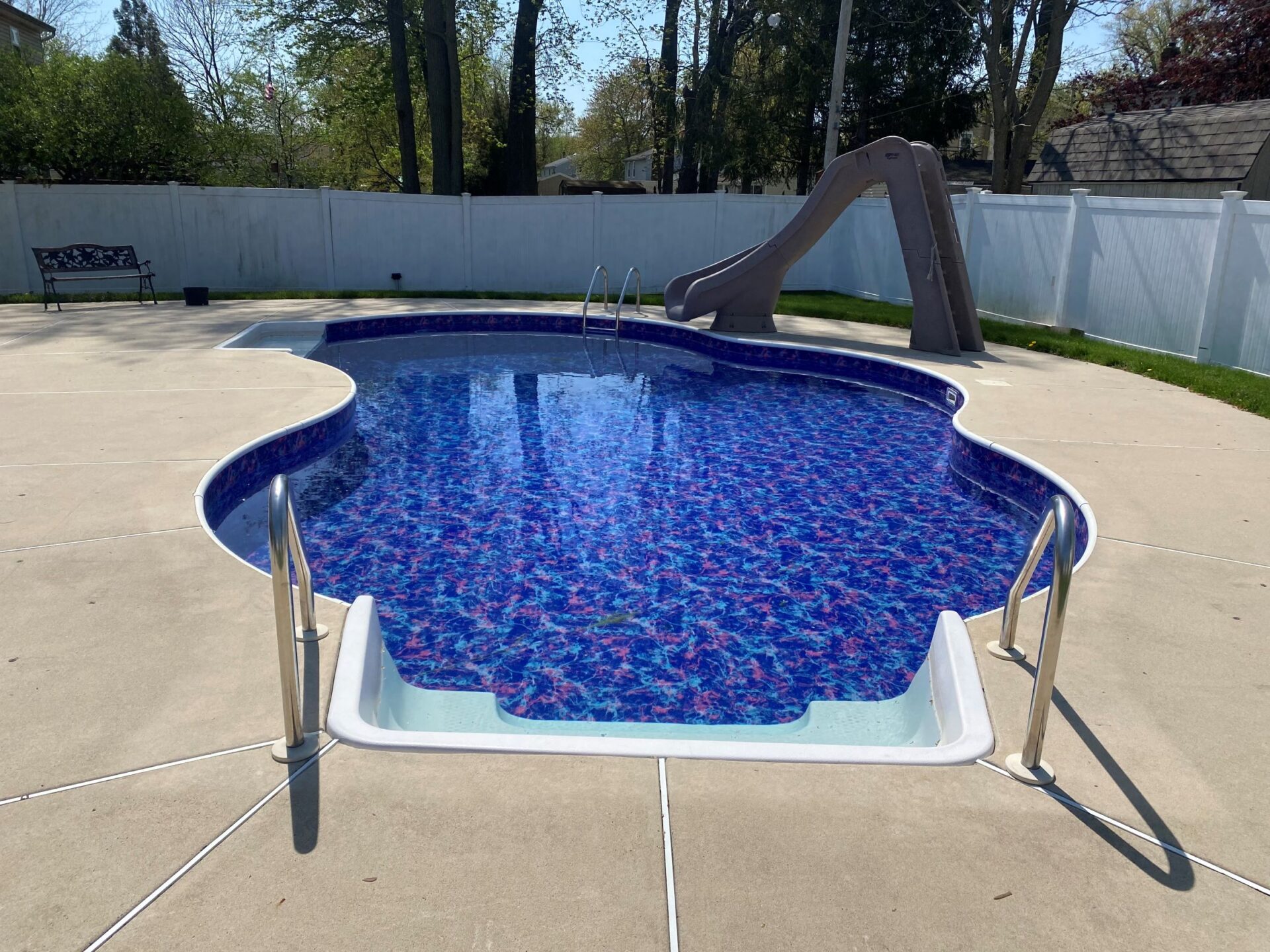So, you’ve got a pool and you’re wondering whether to leave the cover on or off during the day, huh? Well, let me tell you, this decision can make a big difference in your pool’s temperature, cleanliness, and overall maintenance. In this article, we’re going to dive into the pros and cons of leaving your pool cover on during the day, as well as when it’s best to use a pool cover. We’ll also discuss the benefits of taking the cover off and give you some tips for pool cover usage and maintenance. Get ready to make an informed decision about when to leave that cover on or off during the day!
Key Takeaways
- Leaving the pool cover on during the day can protect the pool water from elements, retain temperature, and reduce water loss through evaporation.
- However, it can negatively affect water temperature on hot days and damage the surface of the cover.
- Solid pool covers are suitable for winterizing the pool and protecting it from falling debris, but prolonged exposure to UV rays can damage the cover and promote algae growth.
- It is recommended to leave the pool cover off during the day to allow for natural and even water heating, prolong the life of the cover, and maintain better pH balance in the pool water.
The Benefits of Leaving Your Pool Cover On During the Day
Leaving your pool cover on during the day can help retain the pool temperature and reduce water loss through evaporation. Not only does it provide a barrier against leaves and debris on windy days, but it also has a positive impact on water clarity. Pool cover durability is an important factor to consider when deciding whether to leave it on during the day.
By keeping the pool cover on, you are protecting your pool from the elements, preventing leaves and debris from entering the water. This not only keeps your pool clean but also reduces the amount of time and effort you need to spend on maintenance. Additionally, by reducing water loss through evaporation, you are saving both time and money by minimizing the need to constantly refill your pool.
When it comes to water clarity, a pool cover can play a significant role. By preventing leaves and debris from entering the pool, the water remains clearer and cleaner. This means less time spent on cleaning and more time enjoying your pool.
However, it’s important to note that the durability of your pool cover is crucial. Over time, prolonged exposure to sunlight can damage the surface of the cover, reducing its lifespan. It’s recommended to choose a high-quality cover that is designed to withstand UV rays and other environmental factors.
The Drawbacks of Leaving Your Pool Cover On During the Day
If you keep your pool cover on during the day, it can negatively impact the water temperature and lead to uneven temperatures. This can occur because the cover prevents sunlight from directly heating the pool water, causing it to stay cooler than desired. The potential temperature imbalance can make it uncomfortable for swimming and affect the overall enjoyment of your pool. Additionally, leaving the pool cover on for extended periods can increase the risk of cover damage. The cover is exposed to direct sunlight, which can cause the surface to deteriorate over time, reducing its effectiveness and lifespan.
The Benefits of Taking Your Pool Cover Off During the Day
Taking off your pool cover during the day allows the water to heat naturally and evenly, saving you on heating costs. By removing the cover, you allow the sunlight to directly warm the water, maximizing pool heating efficiency. The heat from the sun penetrates the water, raising its temperature gradually and evenly. This eliminates the need for additional heating methods, reducing your energy consumption and expenses.
Not only does removing the pool cover during the day improve heating efficiency, but it also improves the durability of the cover itself. Constant exposure to sunlight can weaken and damage the cover over time. By giving it a break during the day, you reduce the risk of premature wear and tear. This prolongs the life of your pool cover, saving you money on replacement costs.
In addition to heating benefits and improved durability, taking off the pool cover during the day also helps maintain better balance in pH levels. When the cover is left on for extended periods, it can create a stagnant environment that leads to low pH levels and acidic water. By allowing the water to breathe and circulate during the day, you prevent this imbalance and ensure a healthier and safer swimming environment.
To maximize the benefits of taking off your pool cover during the day, it’s important to store the cover properly when not in use. This will protect it from damage and maintain its condition for longer. Additionally, regularly checking and maintaining chemical levels in the pool water, as well as monitoring and adjusting pH levels, will help prevent damage to pool fixtures and ensure optimal pool health.
The Drawbacks of Taking Your Pool Cover Off During the Day
Removing the pool cover during the day can lead to inconsistent water temperatures and potential heat loss. While there are advantages to keeping the pool cover on during the day, there are also disadvantages to removing it. Let’s explore both sides.
Advantages of keeping the pool cover on during the day:
- Consistent water temperatures: By leaving the cover on, you can maintain the desired temperature of your pool water. This is especially beneficial if you have a heated pool or live in a colder climate.
- Reduced heat loss: The cover acts as a barrier, preventing heat from escaping the pool. This can help save on heating costs and keep your pool warm and inviting.
- Minimized evaporation: Water evaporation can lead to the loss of chemicals and water levels. By keeping the cover on, you can reduce evaporation and save time and money on refilling and balancing the pool.
- Protection from debris: The cover acts as a shield, preventing leaves, dirt, and other debris from entering the pool. This saves you from having to clean the pool frequently and ensures a clean swimming experience.
- Extended lifespan of the cover: Leaving the cover on during the day gives it a break from constant exposure to sunlight, which can damage the cover over time. This helps prolong its lifespan and saves you money on replacement costs.
Disadvantages of removing the pool cover during the day:
- Inconsistent water temperatures: Without the cover, the pool water can lose heat quickly, especially on hot days. This can result in uneven water temperatures, making your swimming experience less enjoyable.
- Potential heat loss: When the cover is off, heat can escape from the pool, leading to increased energy consumption and higher heating costs.
- Increased evaporation: Without the cover, water evaporation rates can increase, leading to the need for more frequent refilling and chemical balancing.
- Exposure to sunlight: Prolonged exposure to sunlight can damage the surface of the pool and reduce the lifespan of the cover. This can result in the need for more frequent cover replacements.
- Debris accumulation: Without the cover, leaves, dirt, and other debris can enter the pool, increasing the need for cleaning and maintenance.
When to Use a Pool Cover: Best Practices
When it comes to using a pool cover, there are several best practices to keep in mind. By following these guidelines, you can optimize the usage of your pool cover and ensure that it effectively balances temperature, minimizes evaporation, and protects against weather and seasonal factors. Understanding when to use a pool cover is key to maintaining the overall health and longevity of your pool.
Optimal Cover Usage
Leaving your pool cover on during the day can help retain the pool temperature and reduce water loss through evaporation. This can be especially beneficial in maintaining a comfortable swimming environment and saving on heating costs. However, there are also potential drawbacks to consider. On hot days, leaving the cover on can lead to uneven water temperatures and discomfort for swimmers. Additionally, prolonged exposure to sunlight can damage the surface of the cover, shortening its lifespan. It’s important to find the right balance and consider the weather conditions before deciding whether to leave the pool cover on during the day. Regularly checking and maintaining chemical levels, as well as following manufacturer guidelines, can help ensure optimal cover usage and prolong the life of your pool cover.
Balancing Temperature and Evaporation
To balance temperature and reduce evaporation, it’s important to find the right amount of time to keep your pool cover on during the day. By doing so, you can maximize energy efficiency and maintain the optimal conditions for your pool. Here are some tips for pool cover maintenance and maximizing energy efficiency:
| Tips for Pool Cover Maintenance | Tips for Maximizing Energy Efficiency |
|---|---|
| – Clean the pool cover regularly to remove debris and prevent damage. | – Use a solar pool cover during the day to heat the water naturally. |
| – Store the pool cover properly when not in use to maintain its condition. | – Remove the pool cover during the day to allow the water to heat evenly. |
| – Check for any tears or damage and repair them promptly. | – Keep the pool cover on at night to retain the water temperature. |
| – Follow the manufacturer’s guidelines for pool cover usage and maintenance. | – Monitor and adjust chemical levels regularly to ensure proper balance. |
| – Consider using a transparent solar cover to allow sunlight to reach the water. | – Insulate the pool with a solid cover during cold weather to reduce heat loss. |
Weather and Seasonal Considerations
Don’t forget to consider the weather and seasonal factors when deciding how long to keep your pool cover on. The choice of pool cover materials and proper installation are crucial for maximizing its effectiveness. Here are some key points to keep in mind:
- Pool cover materials: Different pool covers serve different purposes. Solar covers can retain pool temperature and reduce water evaporation, but prolonged exposure to sunlight can damage their surface. Solid covers protect the pool from debris and harsh winter conditions, but they can promote algae growth if chemical levels are not properly maintained.
- Proper pool cover installation: Ensuring a tight and secure fit is essential to prevent debris entry and water evaporation. Follow the manufacturer’s guidelines for installation and maintenance. Store the pool cover properly when not in use to maintain its condition.
Consider these factors when deciding on the duration of pool cover usage, and make sure to choose the right pool cover materials and install them properly for optimal results.
Additional Tips for Pool Cover Usage and Maintenance
When using a pool cover, it’s important to store it properly when not in use to maintain its condition. Pool cover maintenance is crucial for ensuring its longevity and effectiveness in protecting your pool. Here are some tips for storing pool covers to keep them in optimal shape.
Firstly, make sure to clean the pool cover thoroughly before storing it. Remove any debris, leaves, or dirt that may have accumulated on the surface. This will prevent any mold or mildew growth and keep the cover looking its best.
Next, ensure that the pool cover is completely dry before folding and storing it. Moisture can lead to the development of unpleasant odors or even damage the cover material. Allow the cover to air dry in the sun or use a towel to dry it thoroughly.
When folding the pool cover, be careful to avoid any sharp edges or objects that could cause tears or punctures. Fold the cover neatly and evenly to prevent creases or wrinkles that may be difficult to remove later.
Store the pool cover in a clean and dry area away from direct sunlight. Exposure to sunlight can cause the cover material to deteriorate over time. A cool and dark storage space, such as a shed or garage, is ideal for preserving the cover’s condition.
Consider using a storage bag or container specifically designed for pool covers. This will provide an extra layer of protection and help keep the cover organized and easily accessible for future use.
Winterizing Your Pool Pump and Filter: Important Steps to Take
To winterize your pool pump and filter, there are important steps you should take. First, disconnect and drain the pump and filter to prevent freezing damage. Next, thoroughly clean the pump and filter to remove any debris. Finally, lubricate any moving parts for smooth operation and store them in a dry and secure location. Following these steps will help protect your pool equipment during the winter months.
Preventing Freezing Damage
Leaving your pool cover on during the day can help prevent freezing damage to your pool pump, filter, and heater. This is especially important during the winter months when colder temperatures can cause these components to freeze and potentially break. By keeping the pool cover on, you create an extra layer of insulation that helps to retain heat and protect your equipment.
To ensure proper protection and longevity of your pool cover, it’s important to consider pool cover alternatives and proper pool cover storage. Transparent solar covers and mesh pool covers are great options for debris protection, while storing your pool cover in a dry and secure location will help maintain its condition.
Now that you understand the benefits of leaving your pool cover on during the day, let’s move on to the next section about proper cleaning and maintenance.
Proper Cleaning and Maintenance
When it comes to proper cleaning and maintenance of your pool, there are a few key techniques to keep in mind. Regular cleaning is essential to keep your pool water clean and clear. This involves skimming the surface to remove leaves and debris, brushing the walls and floor to prevent algae growth, and vacuuming to eliminate dirt and particles. Additionally, it’s important to regularly check and maintain the chemical levels in your pool water to ensure proper balance and prevent issues like algae growth or pH imbalance. Common maintenance issues include clogged filters, malfunctioning pumps, and leaks. Regular inspection and servicing of these components can help identify and address any problems early on. By following these cleaning techniques and staying on top of maintenance, you can keep your pool in optimal condition and enjoy a clean and inviting swimming environment.
| Cleaning Techniques | Common Maintenance Issues |
|---|---|
| Skimming the surface | Clogged filters |
| Brushing the walls | Malfunctioning pumps |
| Vacuuming | Leaks |
| Balancing chemical levels | |
| Regular inspection and servicing |
Storage Considerations for Winter
Make sure to properly store your pool cover during the winter months to maintain its condition and prolong its lifespan. Winter pool covers are essential for protecting your pool from freezing temperatures, snow, and debris. Here are some important considerations for cover storage:
- Clean and Dry: Before storing your winter pool cover, make sure to clean it thoroughly and allow it to dry completely. This will prevent mold and mildew growth.
- Folding or Rolling: Depending on the size and type of your pool cover, you can either fold it or roll it up for storage. Follow the manufacturer’s instructions for the best method.
- Storage Location: Find a dry and secure location to store your pool cover during the winter. Avoid areas where it can be damaged by rodents or extreme temperatures.
- Cover Bag: Consider using a cover bag or container specifically designed for pool covers. This will protect it from dust, dirt, and other potential damage.
- Regular Inspections: Throughout the winter months, periodically check your stored pool cover for any signs of damage or wear. This will allow you to address any issues before the next swimming season.
Winterizing a Pool Heater: Essential Precautions
To protect your pool heater from the elements during the winter, consider using a pool cover as an additional precaution. Winterizing your pool heater is essential to prevent damage and ensure its proper functioning when the warmer months roll around. When preparing your pool heater for the winter, there are a few essential precautions you should take.
Firstly, turn off the heater and disconnect it from the power source. This step is crucial to avoid any accidental heating during the winter months. Next, drain the heater and remove any water from the pipes. This will prevent freezing and potential damage to the internal components.
After draining the heater, it’s important to clean it thoroughly to remove any dirt or debris. This will help maintain the heater’s efficiency and extend its lifespan. Once cleaned, store the heater in a dry and well-ventilated area. This will protect it from moisture and ensure it remains in good condition during the winter.
In addition to these steps, using a pool cover is highly recommended for added protection. A pool cover will shield the heater from snow, ice, and other harsh weather conditions. It will also prevent debris from accumulating on the heater, reducing the risk of damage.
Pool Chlorine Pricing: Understanding the Factors Impacting Prices
Understanding the factors impacting pool chlorine prices can help you make informed decisions about sanitization methods. As a pool owner, it’s important to stay informed about the current pricing trends and factors that contribute to the fluctuations in chlorine prices. Here are some key factors that impact pool chlorine prices:
- Increased demand and supply chain disruptions: The high demand for pool chlorine, coupled with disruptions in the supply chain, has led to higher prices. This increased demand can be attributed to more people staying at home and investing in their pools for recreational purposes.
- Shortages of raw materials: Shortages of raw materials used in the production of chlorine, such as salt and chlorine gas, have also contributed to the increase in prices. Limited availability of these materials can disrupt the production process and cause a shortage in the market.
- Transportation costs: Rising transportation costs, including fuel prices and logistical challenges, have added to the overall cost of chlorine. Manufacturers have to account for these increased expenses when setting their prices.
- Manufacturer price increases: In order to cover their expenses and maintain profitability, manufacturers have implemented price increases on pool chlorine. These increases help them offset the rising costs of production and transportation.
- Alternative sanitization methods: Given the current pricing trends and potential shortages, pool owners can explore alternative sanitization methods to reduce their reliance on chlorine. Options such as saltwater chlorination systems, UV sterilization, and ozone generators offer effective alternatives to traditional chlorine sanitization.
Frequently Asked Questions
How Does Leaving a Pool Cover on During the Day Affect Water Temperature on Hot Days?
Leaving a pool cover on during hot days can affect the water temperature. Without the context of the Current Question, it’s important to note that pool covers can trap heat from the sun, causing the water temperature to rise. This can lead to uneven temperatures and make the pool uncomfortable to swim in. However, pool covers also help to reduce evaporation rates and conserve water, making them energy-efficient and environmentally friendly options for pool owners.
Can Prolonged Exposure to Sunlight Damage the Surface of a Solar Pool Cover?
Prolonged sunlight exposure can indeed damage the surface of a solar pool cover. The intense UV rays can cause the cover to deteriorate over time, reducing its lifespan. Additionally, leaving the cover on during hot days may negatively impact water temperature, leading to uneven temperatures in the pool. Furthermore, extended use of the cover can affect pH levels, potentially resulting in acidic water. To mitigate these issues, it’s crucial to consider alternative sanitization methods and regularly monitor and adjust chemical levels in the pool water.
What Are the Potential Consequences of Leaving a Solid Pool Cover on During the Day if Chemical Levels Are Not Properly Maintained?
Neglecting water maintenance while leaving a solid pool cover on during the day can have serious consequences. Without proper chemical levels, algae can flourish, leading to a green and unhealthy pool. Additionally, the pool cover can hinder evaporation, causing imbalanced water chemistry and potential damage to pool fixtures. It is crucial to regularly test and maintain chemical levels to ensure a clean and well-maintained pool. Remember, the pool cover is just one part of pool care; proper water maintenance is essential.
How Can Leaving a Pool Cover on for Extended Periods Impact the Ph Levels and Water Balance of the Pool?
Leaving a pool cover on for extended periods can have a significant impact on the pH levels and water balance of your pool. The cover can trap heat and chemicals, leading to low pH levels and acidic water. This imbalance can affect pool clarity and create an environment conducive to algae growth. It’s important to regularly test and adjust the pH levels, ensuring proper water balance to maintain clear and healthy pool water.
What Are Some Alternative Sanitization Methods That Pool Owners Can Explore to Reduce Chlorine Usage?
Looking for chlorine reduction techniques and alternative sanitization methods for your pool? There are several options to explore. Some popular methods include saltwater chlorination systems, UV sanitization, and ozonation. Saltwater chlorination systems use salt to generate chlorine, reducing the need for traditional chlorine chemicals. UV sanitization uses ultraviolet light to kill bacteria and algae, while ozonation utilizes ozone gas to disinfect the water. These methods can help you reduce chlorine usage and maintain a clean and safe swimming pool.
Conclusion
In conclusion, whether you should leave your pool cover on or off during the day depends on various factors such as temperature, cleanliness, and maintenance. Consider the benefits of keeping the cover on, like maintaining temperature and protecting against debris, as well as the drawbacks, such as potential evaporation. On the other hand, taking the cover off can allow for sunlight and airflow, but may increase the risk of debris and heat loss. Ultimately, finding a balance and following best practices will ensure the optimal use of your pool cover.





